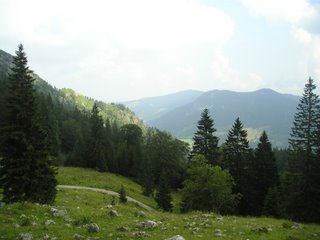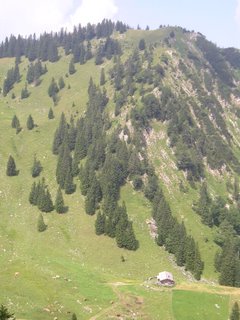It is usual, unfortunately, for ladies to go up to the railings that decorate the takht of Guru Granth Sahib in gurduaras and tie the rakhris onto the railing. I guess they consider the railings the arm of the Guru whom they consider their brother and maybe are seeking protection. Interesting concept...but NOT! Anyway, I saw a blog with pictures of that can't find it now, but hope you know what I mean.
Anyway, at Dixie Gurduara there are no railings around the Guru's takht so women just placed the rakhris right on top of the golak where other sangat members were placing money. By the end of evening divan, the whole golak was covered with rakhris.
During the divan, one Singhni from the sangat got up, picked up all the rakhris from the golak of the Guru, walked towards a garbage can and threw all the rakhris into the garbage. This was in clear view of all the women who had placed the rakhri.
1. When I heard this story, I said "Shabash!!".
2. The Singh who told it to me said "Do you know who the Singhni was?" Then he smiled and looked towards his wife.
3. I said "Vah vah! Good job". So it was a good friend of ours from the Toronto gang.
4. Apparently she got funny looks from the women in the sangat when she did that, but many Singhs came over and congratulated her for her thoughtful and courageous act after ardas.
I don't want to give out her name ...so.... "Good job N. Kaur!!"
Next year during rakhri day, I suggest we (all like minded Singhs and Kaurs) take turns at the Gurduara and every hour on the hour we take all the rakhris that have been left in front of the Guru's takht (or tied to the railings) and throw them in the garbage - preferably in front of the women that leave it there. In addition we hand out essays like the one below. It may hurt some women's feelings, but if we explain why we are doing it, then it may be worth it.
Thoughts?
-------
Rakhri - A Symbol of Oppression Against Women
by Harpreet Singh (Sat Aug 04, 2001 www.Sikhe.com)
Since times immemorial, minorities all over the world have sought comfort through conformism. They have often adopted practices that are antithetical to their own beliefs. We need not go very far for examples. Guru Nanak, for instance, in the Asa Kee Vaar shows the conformism and resulting hypocrisy of Brahmins as they attempt to please their masters and maintain their caste hierarchy.
…They wear their loin cloths, apply ritual frontal marks to their foreheads, and carry their rosaries, but they eat food with the Muslims. O Siblings of Destiny, you perform devotional worship indoors, but read the Islamic sacred texts, and adopt the Muslim way of life. Renounce your hypocrisy. Embrace the true Lord, and attain salvation.
The man-eaters say their prayers. Those who wield the knife wear the sacred thread around their necks . . . Wearing blue robes, they seek the approval of the Muslim rulers. Accepting bread from the Muslim rulers, they still worship the [Hindu] Puraanas. They eat the meat of the goats, killed after the Muslim prayers are read over them, but they do not allow anyone else to enter their kitchen areas. They draw lines around them, plastering the ground with cow-dung. The false come and sit within them. They cry out, "Do not touch our food, or it will be polluted!" But with their polluted bodies, they commit evil deeds. With filthy minds, they try to cleanse their mouths. Says Nanak, meditate on the True Lord. If you are pure, you will obtain the True Lord.
Raag Asa, M. 1, SGGS, p. 471-72
Clearly, conformism is unacceptable to Guru Nanak, who created a sovereign and a defiant race of human beings through his revolution. Unfortunately, some Sikhs today under the influence of Brahminism have become conformists. As a compelling example, let's examine the festival of Rakhri that is celebrated today by many Sikhs who are ignorant of its significance. First, some background grounded in its hoary mythology is in order.
One of the two festivals celebrated during the bright fortnight during the Hindu month of Shravan is Raksha Bandhan, better known as Rakhri among Punjabi Hindus. It is a tradition with ancient roots. Bhavishya Purana refers to a fierce battle that raged between the gods and the demons. From news received from the battlefield it appeared that the demons were getting the upper hand and would gain victory.
Indra, the supreme Hindu deity, summoned his teacher Vrihaspati to his court for advice. Indra's wife Indrani was also present. Before the teacher could speak, Indrani rose and said, "I know how to assure the victory of the gods. I give you my word that we will win." The next day was full moon night of the month Shravan. Indrani had a charm prepared as prescribed by the sacred texts and tied it on the wrist of her husband. And no sooner did Indra appear on the battlefield with the charm on his hand the demons scattered and fled. The demons bit the dust and the gods were victorious.
It would appear that the Raksha Bandhan of today is derived from this belief. It is held that if a chord made according to the prescriptions of the holy texts is tied round the wrist of a person on the full moon day of Shravan it will ensure him good health, success and happiness for the year that follows.
Rakhri has become a sacred festival for Hindus. Sisters tie amulets to brothers. Brahmin Priests tie them to the men of their congregations. Also on this day, it is noteworthy that the Brahmins change their sacred thread, janeoo, which Guru Nanak rejected at a young age because it symbolizes apartheid though its stratification of society. In
Today Rakhri (literally meaning protection) has become popularized as an annual event in Hindu religion where sisters tie amulets to their brothers and seek the male's protection in exchange. The woman conducting aarti before her brother, a ritual Guru Nanak repudiates in the Kirtan Sohila, sometimes precedes the thread-tying ceremony. This is to the accompaniment of her enunciation or chanting of the following mantra in Sanskrit. Yena baddho balee raajaa daanavendro mahaabalah. Tena twaam anubadhnaami rakshey maa chala maa chala. "I am tying on your hand this Raksha, with which the most powerful and generous King Bali himself was bound; O Raksha, don't go away; don't go away."
From a Sikh perspective, Rakhri is undoubtedly another expression of a patriarchal culture, however well intentioned. It is, after all, the brother who extends his protection to his sister, and the woman who agrees to place herself under the protection of her brother. She is devoid of power and must turn to a male for protection. While this is true in Hinduism, where the law giver Manu gives her a place next to animals, it is not the case in Sikhism. Guru Nanak, in his Asa Kee Var, raised the status of woman, making her equal to man long before
How do we reconcile the celebration of a festival so antithetical to Sikhism by Sikhs ? Five hundred years of work by the Sikh Gurus to give women their basic human rights is undercut through such demeaning rituals imbued in Brahminism. Does not the tenth Nanak declare, "When the Khalsa adopts Brahminical ways, it shall lose my trust", jab eh gahe bipran kee reet, mai na karoo in kee parteet?
Guru Nanak demands complete sovereignty through actions. There is no room for conformism and compromises. Sikh women worldwide should resolve to boycott festivals such as Rakhri that dilute the egalitarian message of Sikhism. What could be a better tribute that can be offered to our Ten Masters who fought to give women equal rights when the rest of the world turned a blind eye to oppression against them ?
Harpreet Singh is an information technology professional and a committed, active Sikh. He is the founder of the successful Sikh Heresy Regulation Board that spearheads active campaigns to prevent lapses in the practice of the Sikh faith.












